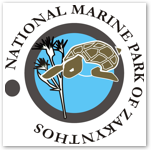National Marine Park of Zakynthos – NMPZ (GREECE)
A Presidential Decree, signed in December 1999 (Official Journal of the Hellenic Republic 906D, 22/12/1999), resulted in the establishment the National Marine Park of Zakynthos (NMPZ), with the purpose to protect and conserve the most important loggerhead sea turtle (Caretta caretta) nesting beaches in the Mediterranean, a population of Mediterranean monk seals (Monachus monachus), resident and migratory bird species and rare and endemic plants. The primary aim of the NMPZ is to monitor various aspects of the natural environment (e.g. species, habitats and impacts), to capacitate the growth of environmentally compatible activities, such as sustainable tourism and recreation, whilst simultaneously safeguarding the natural and cultural landscape through activities such as environmental education, provision of information and public awareness activities. Zakynthos Island is 406 km2, of which 45.4 km2 (or 11% of landmass) falls within the National Marine Park of Zakynthos (NMPZ) and borders the region of Laganas Bay. This area is divided into three terrestrial zones: the Core Zone (Nature Protection Areas) (14.2 km2), the Buffer Zone (Protected Natural Landscapes) and the Peripheral Zone (Eco-development Zone and Tourist Development Zone) (Buffer & Peripheral: 31.2 km2), with an additional 89.2 km2 forming the Marine Protection Area of Laganas Bay and the nearby Strophadia islands. The National Park also includes the Strophadia Islands, which are located 40 nautical miles south of Zakynthos.
The National Marine Park of Zakynthos encompasses three Natura 2000 areas:
- ‘Lagana Bay including Marathonisi and Pelouzo islets’ on Zakynthos (GR2210002) (69.57 km2) is a Site of Community Importance (SCI)
- The ‘Strofadia islands’ 40 nautical miles south of Zakynthos comprise a Site of Community Importance (GR2210003) and a Special Protection Area (SPA) (GR2210004).
Within the NMPZ area three wildlife species (the loggerhead sea turtle Caretta caretta, the Mediterranean monk seal Monachus monachus and the Cory’s shearwater Calonectris diomeda ) and one marine habitat (Posidonia oceanica beds) have been given priority protective classifications under Annexes I and II of the 92/43 Directive and Annex I of 79/409 EEC Directive. The Marine Park’s objectives are to preserve the natural environment and conserve the ecological balance of the marine and coastal area of Laganas’ Bay and Strophadia Islands. Simultaneously it aims to develop new initiatives and/or maintain economic activities compatible with the principles of Integrated Management and Sustainable Development (fishing activity, tourism, sustainable and biological agriculture).
Since it was the first National Park in Greece managed by a management agency (July 2000), it represents the first innovative step for nature conservation in Greece, by setting and example how nature protection can be harmonized with anthropogenic activities by creating sustainable development for the region.
According to the census 2001, about 6300 people are living in the peripheral and core area of the NMPZ, that is to say 16% of the Zakynthos’ island total population.








